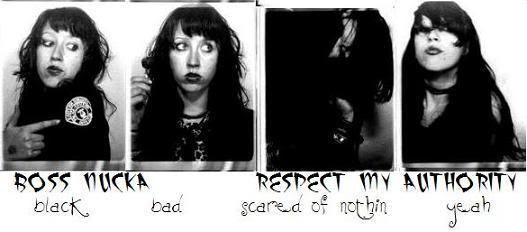
|
|
||||||||||||||||||||
|
|
 |
|
||||||||||||||||||
|
|
||||||||||||||||||||
|
|
|
|
|
|
|
|
|
|
||||||||||||
|
|
|
|
|
|
|
|
|
|||||||||||||
|
|
||||||||||||||||||||
|
#21
|
||||
|
||||
|
Quote:
Angus MacEagleWhoFightsBears |
|
#22
|
||||
|
||||
|
me

__________________
No. |
|
#23
|
||||
|
||||
 Oops I made Rosie O'Donnell
__________________
stop the world - I want to get off 
|
|
#24
|
||||
|
||||
|
i'm trying to mask my suprise at all the 'goth' lego people ..
who'd a thunk ??!! |
|
#25
|
||||
|
||||
|
Quote:
__________________
...  If you can't dazzle 'em with brilliance...Baffle 'em with bullshit My Karma ran over my Dogma God WAS my co-pilot...But, we crashed in the mountains and...I had to eat him I'm suffocating in what's become of me... The rancid remains of what I used to be |
|
#26
|
||||
|
||||
|
me....

|
|
#27
|
||||
|
||||
|
My girlfriend
|
|
#28
|
||||
|
||||
|
Quote:
Modern subculture By the late 1970s, there were a small handful of post punk bands in Britain that were being labeled "gothic". However, it was not until the early 1980s that gothic rock became its own sub-genre within post punk and that followers of these bands started to come together as a distinctly recognisable group or movement. The opening of the Batcave in London's Soho in July 1982 might be seen as marking the coming out of this scene (which had briefly been labeled positive punk[1] (http://www.scathe.demon.co.uk/posipunk.htm) by the New Musical Express). Independently of the British scene, the late 1970s and early 1980s saw death rock branch off from American punk. With similar themes and dress, goths and death rockers were sufficiently compatible to more or less merge. The word goth, as a label for fans of gothic rock, did not start gaining currency until around 1983. Influences of goth also might root in the 50ies Beat Generation movement. Etymology: ancient Goths and medieval architecture Goth was originally the name of two Germanic tribes; Ostrogoths and Visigoths, that lived near the borders of the Roman Empire and later penetrated those borders. The Visigoths sacked Rome and settled in Spain and France while the Ostrogoths settled in the eastern empire but later invaded Italy. The term "goth" became pejorative, synonymous with "barbarian". (Interestingly, another Germanic tribe that caused incredible damage to the Roman Empire were the Vandals, resulting in their name acquiring a pejorative meaning.) Like most of the Germanic tribes that lived near the borders of the Roman Empire, the Goths were converted from "paganism" to Arian Christianity while the Roman Empire converted to Catholic Christianity. The latter considered the former to be heresy, not helping the barbarian association with the word "goth". During the Renaissance period in Europe, medieval architecture had been retrospectively labeled "gothic", considered barbaric in contrast to trends in architecture during the Renaissance. Gothic medieval architecture often had dark and intimidating aspects, with depictions of gargoyles and other demon-like forms. By the 1700s, people became fascinated with medieval gothic ruins (even building fake ruins), and they became a perfect setting for horror fiction. Gothic horror The gothic novel, of the early nineteenth century, was responsible above all else for the term gothic being associated with a mood of horror, darkness and the supernatural. They established what horror stereotypes became by featuring graveyards, ruined castles or churches, ghosts, vampires, cursed families, and melodramatic plots. A notable element in these novels were the brooding figure of the gothic villain, which developed into the Byronic hero, a key precursor in the male goth image. The most famous gothic villain of this genre would be Dracula. In 1993 Whitby became the location for what became the UK's biggest goth festival as a direct result of featuring in Stoker's Dracula. The work of Edgar Allan Poe, master of the gothic short story, has also been an inspiration for many goths. Also, the modern figure of the femme fatale, which has its roots in Romantic literature, is a key image for female goths. Gothic literature lives on with authors such as Anne Rice (Interview with a Vampire). Cinematic horror An important medium between the goth scene and gothic literature is the modern popular horror genre, in which the horror film is paramount. One of the earliest impersonators of cinematic goth might be the silent movie actress Theda Bara. Imagery from horror films and television, especially the figure of the vampire and even camp horror B films such as Plan 9 From Outer Space have had significant influence on the evolution of Gothic fashion. Hammer Horror films and 1960s TV series, such as The Addams Family, The Munsters, and Ann Radcliffe, have also inspired goths. The interconnection between horror and goth was highlighted in its early days by The Hunger, a 1983 vampire film, starring David Bowie, which featured gothic rock group Bauhaus' performing Bela Lugosi's Dead in a nightclub. Some of the early gothic rock and death rock artists adopted horror movie images and passed them onto their goth audiences. Such references in both their music and image were originally tongue-in-cheek, but as time went on, bands and members of the subculture took the connection more seriously. As a result, morbid, supernatural, and occult themes became a more noticeably serious element in the subculture. Some notable movies with strong gothic influences are The Crow, The Matrix Trilogy, and, very important, the movies of Tim Burton (Edward Scissorhands, Nightmare Before Christmas, Beetlejuice, or Sleepy Hollow) Goth after post punk After the demise of post punk, goth continued to evolve, both musically and visually. This caused variations in style ("types" of goth). Local "scenes" also contribute to this variation. By the mid 1990's, Victorian fashion had worked its way into the goth scene, with the mid-19th century Gothic Revival and the morbid outlook of the Victorians (partly owing to the state of national mourning which developed in response to Prince Albert's death, and partly to the Victorians' general obsession with Christian funeral practices). The 2003 Victoria and Albert Museum Gothic exhibition in London furthered a tenuous connection between modern goth and the medieval gothic period. Since the late 1990's, influences from anime have also crept into the Goth scene, which helped give rise to cybergoth. References Hodkinson, Paul: Goth: Identity, Style and Subculture (Dress, Body, Culture Series) (Berg, UK, September 2002; hardcover ISBN 1859736009; softcover ISBN 185973605X) Voltaire: What is Goth? (WeiserBooks, US, 2004; ISBN 1578633222) - a humoristic and easy to read view at the Goth subculture Baddeley, Gavin: Goth Chic: A Connoisseur's Guide to Dark Culture (Plexus, US, August 2002, ISBN 0859653080) See also Gothic Rock Post punk Death Rock Gothic fashion Gothic Metal Sexual Fetishism External links The h2g2 entry on Goth culture (http://www.bbc.co.uk/dna/h2g2/A473924) The International Gothic Club Listing (http://www.vamp.org/Gothic/clublist.html) — Worldwide Goth club directory that is sorted by region. Content is contributed by visitors and usually consists of club specifics such as location, music type, cover charge, drinks, dress code, directions and other miscellaneous club information. Deathrock.com (http://www.deathrock.com) ScatheWeb History of Goth (http://www.scathe.demon.co.uk/histgoth.htm) "Undead Undead Undead (http://www.gothics.org/subculture/articles/undead.php)" (Alternative Press November 1994 article by Dave Thompson and Jo-Ann Greene, with retrospective quotes from early '80s post punk bands on the "goth" label) The Slimelight Club (http://www.slimelight.net/Sportal/) NYDecay (http://www.nydecay.com) Mick Mercer (http://www.mickmercer.com/) |
|
#29
|
||||
|
||||
|
but to be more specific :
Gothic fashion is a style of dress of young people who identify themselves as goths. It is allied to Goth music, but not all those who dress in this fashion listen to Goth music. Typical goth dress consists of black clothing accessorized with silver and/or pewter. The sterotypical gothic outfit, referred to jokingly as the "mopey" or "romantic" look, is limited only by what the wearer thinks he or she can pull off, and can (and frequently does) include elaborate gowns and corsets, veils, teased hair, lots of eyeliner, fishnets, and styles borrowed from the Elizabethans and Victorians. Also popular are tight-fitting trousers, flouncy shirts in the manner of Lord Byron, and anything with buckles on it. The nature of the event will to some degree dictate the dress code, but personal style is generally more important, and it's not unusual for several club-goers on a given night to appear dressed to the nines for no apparent reason. The simplicity of the style lends itself to variation, and it is often seen combined with elements of other styles (typically punk or BDSM fashion). Various piercings are not uncommon, and both males and females often wear dark makeup. Hair is most often dyed a flat, matte black. There are similarities between goth fashion and black metal fashion, which can make it difficult to discern the subculture of the individual. This may present a problem, since goths tend to not like black metal, and metalheads tend to not associate with goths. Gothic fashion is a part of the identity practices of the goth subculture. As such, a person's style (including their clothing, hair, makeup, accessories), is a major factor in determining whether the person will be perceived as authentic by others in the subculture. This is not particular to goth; rather, it is a feature of many subcultures. Members of the subculture may and often do have different ideas about what consitutes gothic fashion than members of the population at large, and some styles which read as "goth" to many people are seen as "outsider" by those in the scene. In his book Goth: Identity, Style and Subculture (Berg Publishers Ltd., Oxford, 2002), Paul Hodkinson talks about goths using their fashion choices to demonstrate commitment to the subculture. In particular, he asserts that more extreme, less easily concealed choices -- such as dyeing ones hair or shaving part of it off -- demonstrate greater commitment. However, the core of gothic fashion is that whatever you like is fine, as the gothic culture per opposition to "fun society" is against the rules of how one has to to look. While there are recurring patterns in the clothing, many different and unique outfits can be witnessed in events like the Wave Gotik Treffen in Leipzig, where the color range ranges from complete white to pitch black. Between those two extremes, anything goes, be it modern, classic, conservative or ragged. Occasionally, goths will tear or cut their clothes apart, normally with scissors, then repair their clothes with safety pins. This gives an odd 'Splitting at the Seams' look. |
|
#30
|
||||
|
||||
|
Goth came from punk rock... not metal. Geez. understand your roots.
"I get no respect... no respect I tell ya'" |
 |
|
|